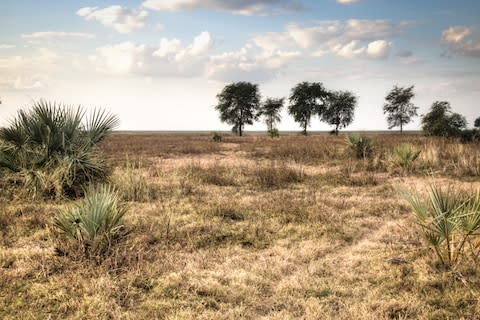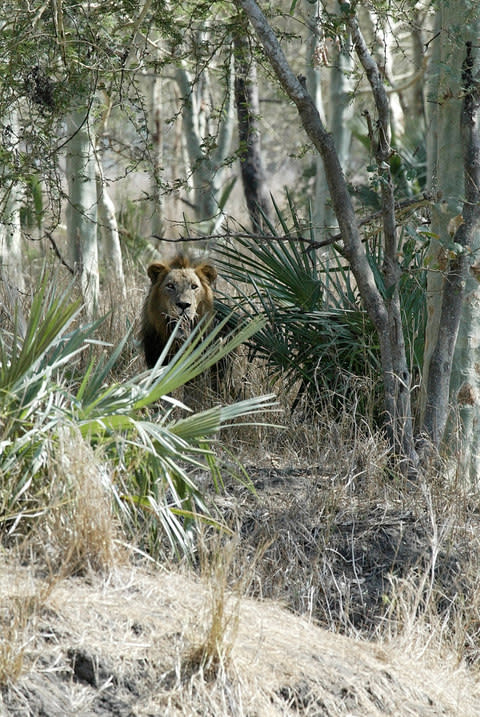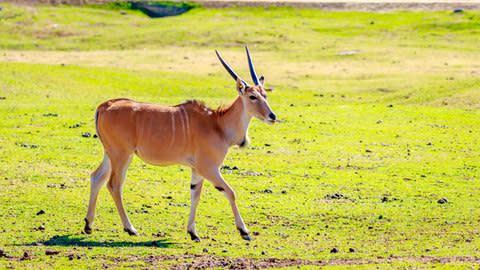Exclusive extract from A Cheetah’s Tale – a new book by Princess Michael of Kent

It was during a safari with my father, close to Gorongosa National Park in Mozambique, that I saw my first big cat in the wild at the age of 17. I had heard many stories and seen pictures, but none compared with the majesty of a lion, leopard or cheetah in its natural surroundings.
Now that I was in the bush, I kept a close watch for the big cats and that same day I saw a leopard. The early morning sun glowed on his muscled, black-spotted tan body. He was halfway up a tall tree, jumping forwards in slow, controlled leaps, almost as if he were counting between each effort made as he lifted up an antelope much larger than himself in his powerful jaws.
“Pantry,” said my father, as I watched the leopard wedge the antelope between two high branches. “I suppose you know that a cheetah will only eat fresh-killed meat, but leopards and lions will happily eat carrion, and this leopard will feast on its kill for some days.” In the cooler afternoon we went out from the camp again, this time driving not walking, and Papi showed me herds of zebras, ostriches, wildebeest and buffaloes.
Supper was a cosy affair – a delicious saddle of antelope cooked on the open fire with wild herbs, local rice and red peppers, then a cake we had brought with us to be eaten with sliced oranges. That night there was to be a full moon and, if we were fortunate, we might see buffaloes leaving the national park some distance below the escarpment to cross the Pungwe River and feed on the maize on the other side.

So much happens by full moon in Africa – or it has in my case, and this night was no exception. Even after all these years and many visits to Africa, I have never seen the moon larger, nor more orange, nor glowing more strongly. As we sat and watched it rise, our binoculars trained on the river sparkling in the moon’s reflected light, I saw the buffaloes, at least 20 of them, cross over slowly to feast on the maize, shaking their great heavy heads and mooing softly to one another. The sound of their crunch-crunching on the maize husks rose up to our observation spot. Strange, the images that remain with one. I did not stay up to watch them slip back across the river.
The following morning we rose early and drove across open country, watching the animals rising, the clear shape of where they had lain during the night still visible in the dew-covered grass. We had been driving for a couple of hours and seen much game, when I spied my first cheetah. We had stopped for morning tea on a termite mound, which are often as high as a small house, perhaps 10 or 12ft, and can be very old. Cheetahs especially use them to study the landscape for potential prey, but this time we were the observers. We spread our tablecloth on the top and were unpacking our sandwiches and thermos of tea, when to my horror I saw ants appear from everywhere and crawl over everything. I looked at my father, who grinned, and I watched in awe as he picked up a sandwich covered in ants, bit and munched happily. “Adds to the flavour – you’ll see,” and I guess they did.
Then he pointed and I lifted the binoculars hanging around my neck. There he was – in a large stretch of dry grass – my first cheetah about to make his charge. I zoomed in and watched open-mouthed as he ran, his action indescribably elegant, almost floating above the ground alongside his antelope target, whirling and twisting as he shadowed it, his long, white-tipped tail swinging to balance him as he made sharp turns.

The antelope managed to escape, but that day I saw for the first time a cheetah at full speed hunting, and the thrill of it engulfed me. I had missed the stalk, but I felt confident there would be other opportunities.
To help me to really get the feel of the wild animals, Papi decided that we should drive into the national park itself, situated a little way on the other side of the river from our camp. It was the size of a small country and here, Papi promised me, I would be able to see the best of the local wildlife. We left at daybreak for our game drive there. As we drove down the escarpment towards the river, patches of fog drifted over the water; the sun was just rising, a beautiful morning as we headed for the pontoon bridge. Arriving at the river bank I recoiled at the sight of the many crocodiles, huge slugs the colour of the mud they lay in, eyes almost closed, malevolent. We drove over the bridge in the general direction of Chitengo, the park headquarters, then up the mountain road to Bue Maria, where we turned off to the right and into the park.
Already at the entry gate I was impressed by the smart way the formalities were conducted and the clear interest in conservation there. We drove in and stopped almost at once. Before us lay a wide, wide valley; on the horizon white clouds were lit by the sun, and all around us was forest – not more than three miles from the park entrance.
We drove a further five or six miles to the main camp where we checked into our bungalows. As Papi was not familiar with the roads in the park, we decided to take a guide. We had hardly left the campsite when we saw game to the right and left of the road, mainly wildebeest, zebras and impalas, but also small gazelles. To my surprise, the impalas were reasonably tame and we were able to approach quite close.
Papi said the reason was that inside the park they knew they were safe from hunters and I would be astonished how close we would be able to get to other animals as well. Wherever we looked there were enormous herds of every kind around us and the steppes were teeming with wildlife – an extraordinary sight to my novice eyes. But Papi said we had actually not seen much as yet.
“Look,” he said suddenly, and there stood my first buffalo. “Now that’s a big bull! Look at him!” he urged, his excitement palpable under his controlled exclamation.
Just then, the buffalo climbed out of his wallow, came towards us and stood about 30 yards from the jeep. He was a breathtaking sight, chewing slowly side to side and shaking his head, with several small birds – oxpeckers – sitting on his back, attending to ticks and the like. He stayed just long enough for me to take him in from top to toe before he moved slowly on his way.
The same morning our guide had told us that lions had killed a zebra quite early. From a distance we had seen the big maned lion lying by the carcass, roaring his pleasure at the success of his hunt. We decided to visit him once more. Papi spotted him first – “Look, there he is, the ‘old gentleman’, in the shade of an acacia” – and about 30 yards from him, we saw his consort and three full-grown cubs. Only the skeleton of the zebra remained.
As we drove several times round these lions, at a distance of 20 or 30 yards, we saw that they were not in the least disturbed by us; they did not even stand up to growl. They just lay there, sated, and observed us dully. Once I thought I saw a warning glance from the male when we came a bit too close, but I could have been wrong. On we drove, I thrilled to have witnessed this.
We continued to watch more game: waterbuck, even a herd of eland – the world’s largest antelopes, huge, amazing beasts, with thick, twisting horns pointing backwards – standing not far from us, though they kept a wary distance since the lions were between us and them.
It was towards the end of that first remarkable day in Gorongosa that I saw two cheetahs hunting – two young brothers from the same litter, whispered our guide. I watched, hardly daring to breathe, as they slowly crept up towards their quarry from either side in the long grass, the one inching towards an antelope, driving it towards the other lying in wait, ready to spring. I saw how they both flattened their bodies and lowered their heads in the dry grass, completely camouflaged as they crept nearer. I continued to hold my breath as they edged closer – and then one of them rocketed forward.

Their plan worked. The antelope panicked and ran straight to the other cheetah. A quick slash with his sharp dewclaw unbalanced the prey; it hit the ground, a scurry, a pounce, and for a moment I saw nothing in the swaying golden grass. Then both cheetahs were there, one holding the antelope fast by the neck which it had tipped back, choking it. The other cheetah had already opened the antelope’s stomach with its cheek teeth, but Papi assured me the poor creature was dead and not in pain.
The cheetah’s dewclaw, he went on, is a formidable weapon, growing just above the forepaw and bigger than a lion’s – “It’s the cheetah’s main killing tool, used for hooking and slashing at its prey.” We sat a while as the brothers ate, but happily not close enough to upset my – as yet – untrained and squeamish young self. Now and then they looked up towards us, disinterested, their muzzles quite red.
The old park guide distracted me from the disembowelling by explaining that cheetahs are by nature solitary animals, but that sometimes a pair of brothers like these will not only hunt together, but even team up with another pair or a solitary male. These young ones can bond to form a group – called a “coalition” – and hunt together, and in this way they can bring down larger animals such as zebras or wildebeests. A male coalition can stick together for life and each individual grows to be stronger and even lives longer than a solitary cheetah.
Females usually hunt alone, though litter sisters and a mother may have overlapping home ranges; as males approach adulthood, they move away from their mother’s range to avoid inbreeding. The female’s solitary life is one of the reasons for the decline in the cheetah populations, since a mother has to leave her small cubs in her lair while she goes and hunts for her daily ration of fresh meat. Not before they are seven to eight weeks old will she encourage them to come to watch her hunt. A litter can consist of two to six cubs, but it is rare that more than two or three survive to adulthood, except in areas where game is particularly plentiful.
Top 5 | Places to see cheetahs
No sooner has there been a kill in the wild than the bush telegraph operates: birds of prey circle overhead, a sure signal to other predators that fresh food is available nearby. Then, before the cheetah has dragged its kill to some quiet spot under low branches, it may be challenged by another predator, eager to see what is going for free. With little time to spare, the cheetah will first chew open the soft skin of the inner thigh, using its cheek teeth like scissors. It will then eat quickly, moving to the nutritious rump, abdominal muscles and back.
If the successful cat is a lactating female with cubs, she will return to her lair and feed her young. If they are watching, and she is not challenged for the kill, she may drag it under some scrub or bush and fetch them to join her. Should she have to relinquish her kill before eating enough, she must go out to hunt again, knowing she is leaving her cubs once more alone and vulnerable.
Even if the female does not bring meat back to her lair, her smell and that of her cubs there will still attract predators. Therefore, she will have to move her young to a fresh lair, one at a time, and often more than once, without attracting attention before she goes to hunt. With so many hurdles to overcome, small wonder the cheetah is the most vulnerable of the big cats in Africa.
The essentials
A Cheetah’s Tale, by Her Royal Highness Princess of Michael of Kent, is published by Bradt Guides at £20. To order your copy for £16.99 plus p&p call 0844 871 1514 or visit books.telegraph.co.uk.
Come and meet Her Royal Highness Princess Michael of Kent at a special launch event at the Royal Geographical Society in London on Tuesday October 17, where she will be signing copies of A Cheetah’s Tale and discussing her lifelong passion for Africa and big cats. TIckets are available here.
The 50 best safari holidays

